Dee Estuary Birding
Monthly Newsletter...
October 2024
Newsletter

Our Dee Estuary Project
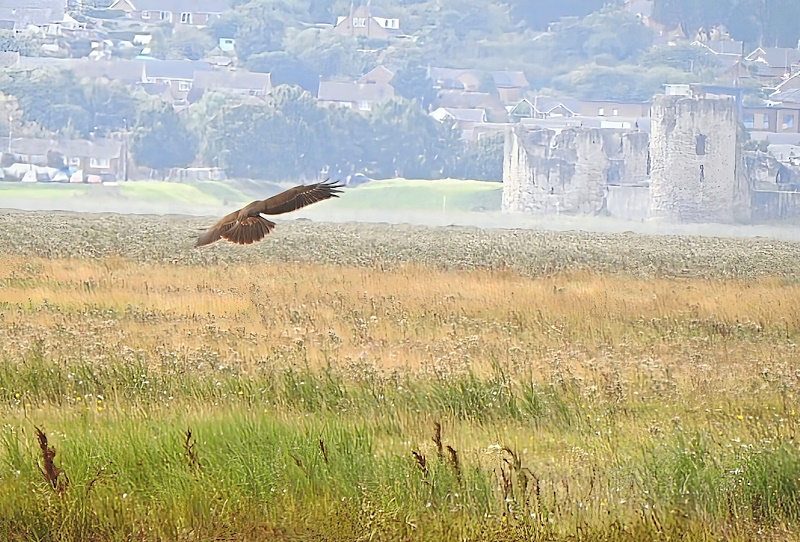
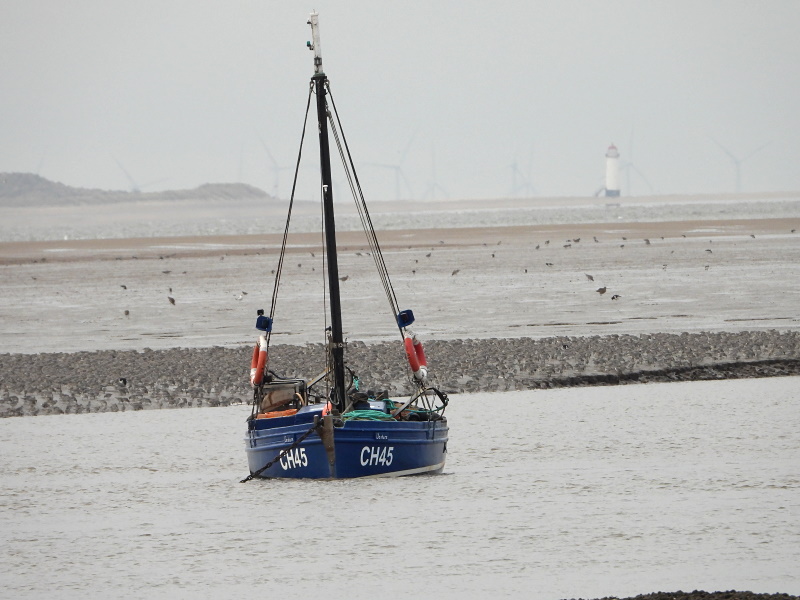
Photos by Nigel Favager (top) and Richard Smith (bottom)
The River Dee catchment area (the entire area
the water for the river comes from) covers an area of 2,251 square
kilometres, mainly in Wales but also in England. The River Dee’s
journey begins at the source in the mountains and lakes of the
Snowdonia National Park and it runs to the internationally significant
intertidal and wading bird habitat of the Dee Estuary. Which is where
the Our Dee Estuary project area begins.
Our Dee Estuary is a cross-border partnership project led by Cheshire
Wildlife Trust, on behalf of the Tidal Dee Catchment Partnership and
funded by the National Lottery Heritage Fund. It brings together a
variety of local organisations with an interest in the Dee
Estuary. These include local authorities, water companies, Natural
England, Natural Resources Wales and the RSPB.
Our Dee Estuary, aims to inspire coastal communities around the Dee
Estuary, in both Wales and England, with their natural heritage to
create a new community of stewardship to effectively conserve and
safeguard the wildlife significance of the Dee Estuary. Key aims
of our project are to:
- Improve governance and collaboration between stakeholders around the Dee Estuary
- Reduce negative environmental impacts along our estuary
- Break down access barriers and help a wider range of people enjoy the estuary and develop new knowledge without putting the heritage at risk.
- Create a nature based sense of place around the Dee Estuary, increasing engagement with the estuary from local communities.
- Improve wellbeing of communities and create a better place to live/ work/ play
- Increase understanding of habitat importance and the species present along the Dee
- Better manage, protect and record our natural areas
As I’m sure you’re all well aware, the Dee Estuary is home to at least
120,000 wetland birds each winter. This is the 7th highest
overwintering population on an estuary in the UK. The Dee Estuary is
also a Site of Special Scientific Interest (SSSI), Special Protection
Area (SPA), Special area of Conservation (SAC) and Ramsar site. SPA’s
and Ramsar sites are specific to bird species and wetland habitats,
again demonstrating the importance of the Dee Estuary for wetlands
birds on a national and global scale.

Our project started back in 2021, with thanks to national lottery
players, and since then we’ve managed to achieve a lot. Our funding has
allowed for big habitat conservation works to occur at:
- Neston reedbeds which included a channel of wet barriers through the reedbed
- development of a 1.5ha wader scrape at RSPB Burton mere
- improved access at Heswall Fields, as well as improving access in Gronant and Bettisfield.
Aside from the practical work, our project also runs
regular species
specific surveys throughout the summer months as well as warden and
volunteer roles such as that at North Wales little Tern Group at
Gronant. Having close connections with local friends of groups means we
can truly listen to what it is needed. We are part of ‘Operation
Seabird’ which aims to address issues of wildlife disturbance through
education and we regularly partner with Dee Estuary Volunteer wardens,
RSPB Burton mere and Little Tern Group North Wales for bird watches
that are open for the public to drop by. Coming up, we will be holding
winter wader webinars through the winter as well wading bird walks out
on the Dee Estuary itself and these will be run along side
professionals in the field from RSPB, the BTO and Wirral Country Park
Rangers.
You can find out more about our project here and more about the Tidal Dee Catchment
Partnership here.
Carys McMillan
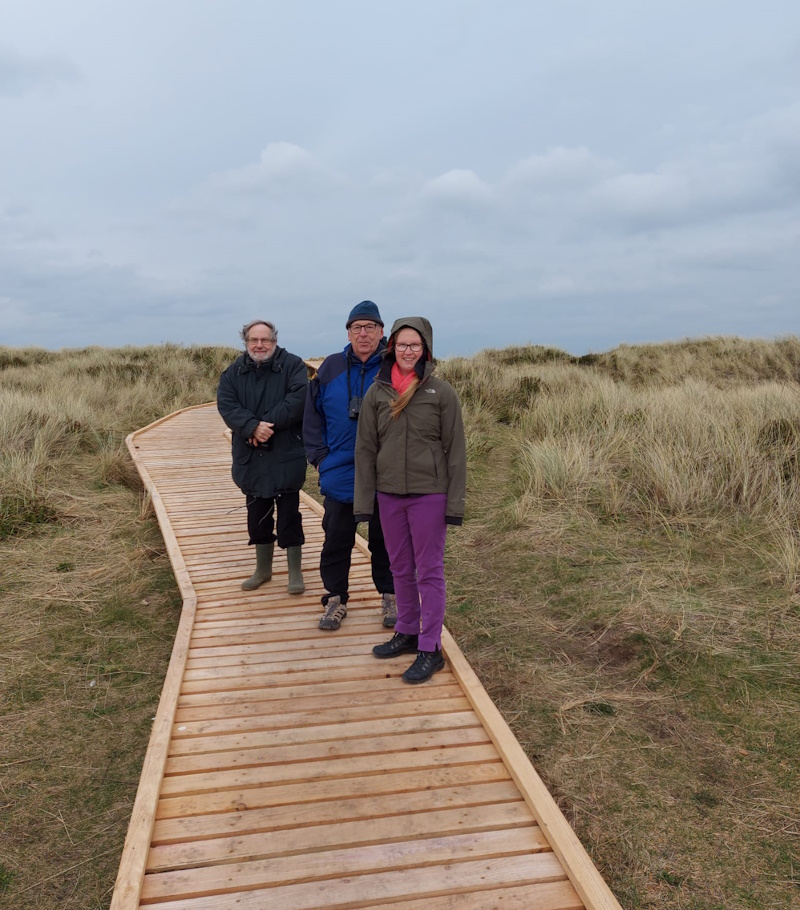
Colour Ring Report
Rock Pipits
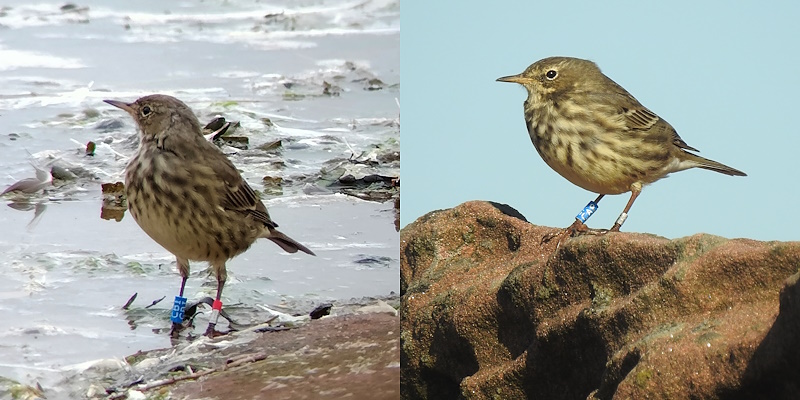
© Chris Wilding (left) and Paul Ralston (right)
Blue CBI
Ringed on Hilbre as a juvenile on 19/08/2024. it's been recorded a
couple of times since including 7/09/2024.
Blue CAP
Ringed on Hilbre as a 2nd calendar year bird on 10/02/2024, it's
sighting on 17/09/2024 at Hilbre is the first record since then.
The colour ringing of Rock Pipits on Hilbre
continues with at least 25 now with blue rings. It will be fascinating
to see how these birds disperse through the winter and in subsequent
years.
Little Egrets
There was a record WeBS count
of 620 Little Egrets on the Dee Estuary in August, no doubt bolstered
by a good breeding season. A lot breed around the estuary but many also
fly in from other breeding colonies and we've seen a lot of juveniles
arriving from both Hale Duck Decoy (on the north shore of the Mersey
Estuary) and Penryn on the north Wales coast near Bangor. Here are
details of four of them:
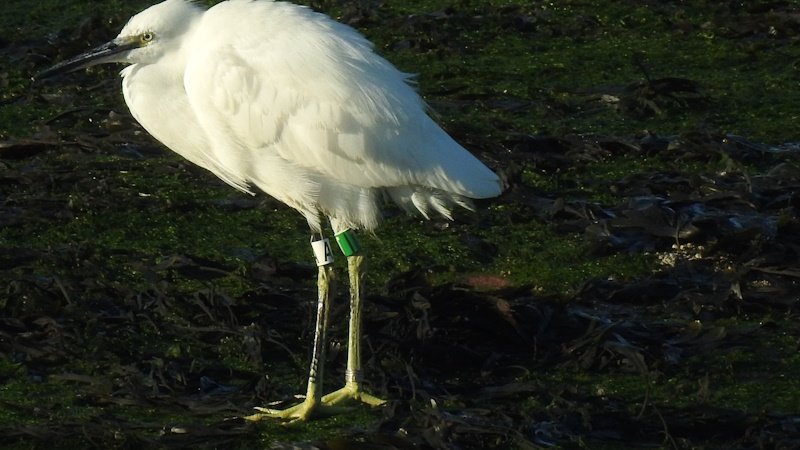
White (A) Green (T)
Ringed in the nest at Hale Duck Decoy on 10/05/2024,
one of a brood of four.
First recorded on the shore around Hilbre on 27/08/2024 and several
times during September.

White (A) Yellow (Z)
Ringed at Penrhyn Castle (near Bangor) on
06/06/2024, as a chick.
Recorded at Thurstaston on 17/08/2024.
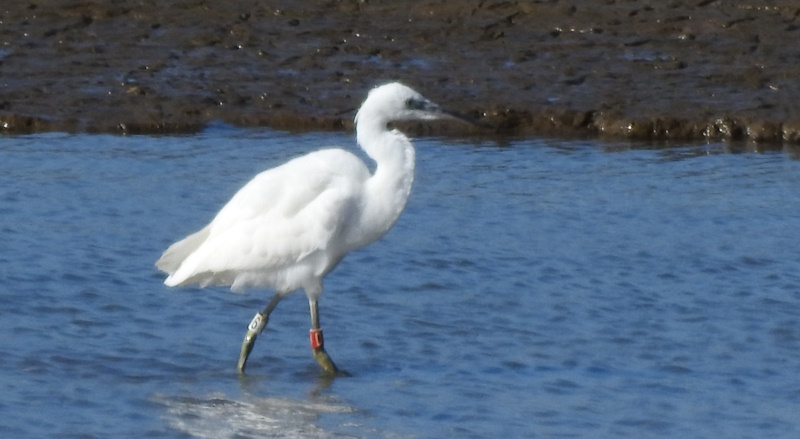
White (6) Red (D)
Ringed at Penrhyn Castle (near Bangor) on
06/06/2024, as a chick.
First recorded at Thurstaston on 13/08/2024 and was present for the
rest of the month and into early September.
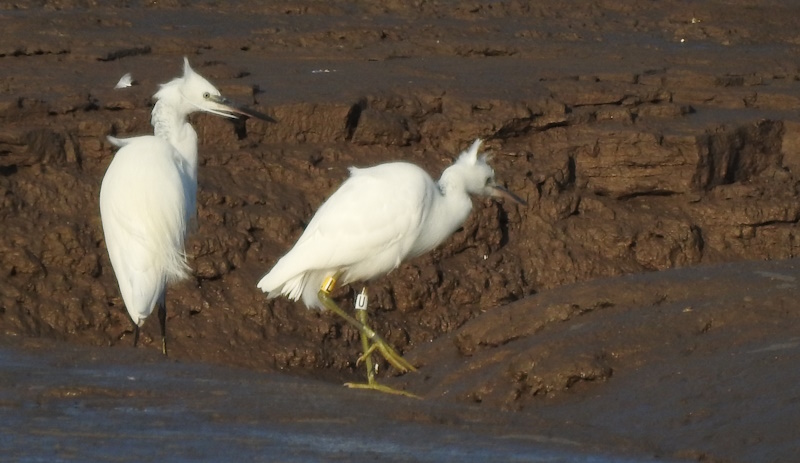
White (U) Yellow (L)
Ringed at Penrhyn Castle (near Bangor) on 26/05/2024, as a chick.
First recorded at Thurstaston on 15/07/2024 and was then present until
at least the end of August.
Cormorant
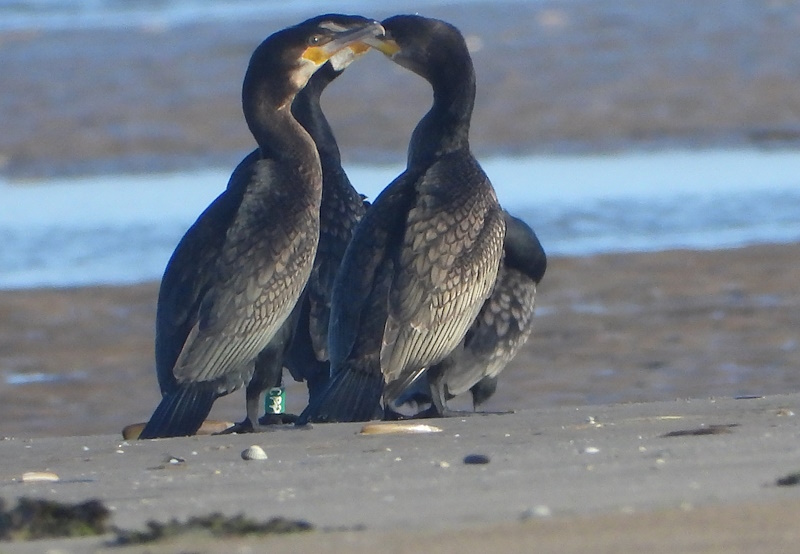
Green (CPP)
Ringed on Puffin Island (Anglesey) on 18/06/2011.
This one spends it's winters around the Normandy beaches used for the
D-Day landings.
It was on Omaha Beach in October 2011 but then not recorded again until
January 2017 when it was just to the south of Utah Beach. The following
three winters saw it in the National Nature Reserve of Beauguillot,
which is just to the south-east of Utah Beach.
Recorded on East Hoyle Bank, near Hilbre, on 14/08/2024.
Shelduck
We see quite a few colour-ringed Shelducks in autumn
with most
being ringed at Martin Mere, where many spend the winter feeding on the
food thrown out for the swans. More unexpectedly we also see some which
have been ringed on the Lower Derwent Vallet National Nature Reserve in
Yorkshire, including this one below:
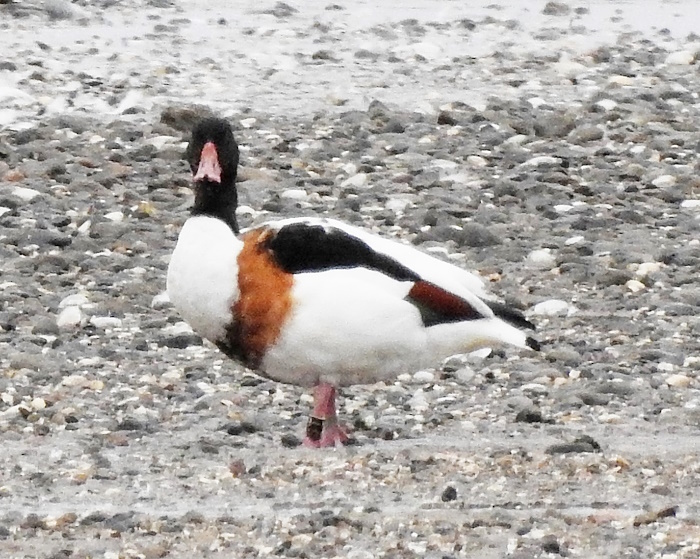
Black (ST)
Rnged as a duckling at the Lower Derwent Valley NNR in June 2007.
When it was first seen at Thurstaston Shore, in September 2022, it was
its first record away from the ringing location. Since then it has been
recorded at Thurstaston in September 2023 and on 18/09/2024.
This bird is now over 17 years old. The longevity record for Shelduck
is 19 years and 10 months, interestingly that was also ringed at Lower
Derwent Valley NNR having been ringed in 2001 and last recorded in
2021.
Redshank
The Dee Estuary is the most important site for
Redshanks in the country with typically around 10,000 present over
August and September. Within the Dee Estuary the most important site is
the Heswall and Thurstaston area, it is hard work finding ones with
colour rings but, thanks to Steve Hinde, we did manage to find at least
six over the past few weeks. These included one from Lower Derwent
Valley NNR - the same place as the Shelduck was ringed, above. All the
rest were ringed on the Cardigan Bay coast, perhaps not an obvious
place for our Redshanks to come from and it reflects the large number
of birds that the Mid-Wales Ringing Group ring who do a tremendous job
keeping us busy reading their rings! Here are details of three of the
ones seen recently.

Black (41) - Y
Ringed a
Lower Derwent Valley NNR, Yorkshire, in December 2023, as an adult.
Recorded on Heswall Shore on several dates in August 2024.
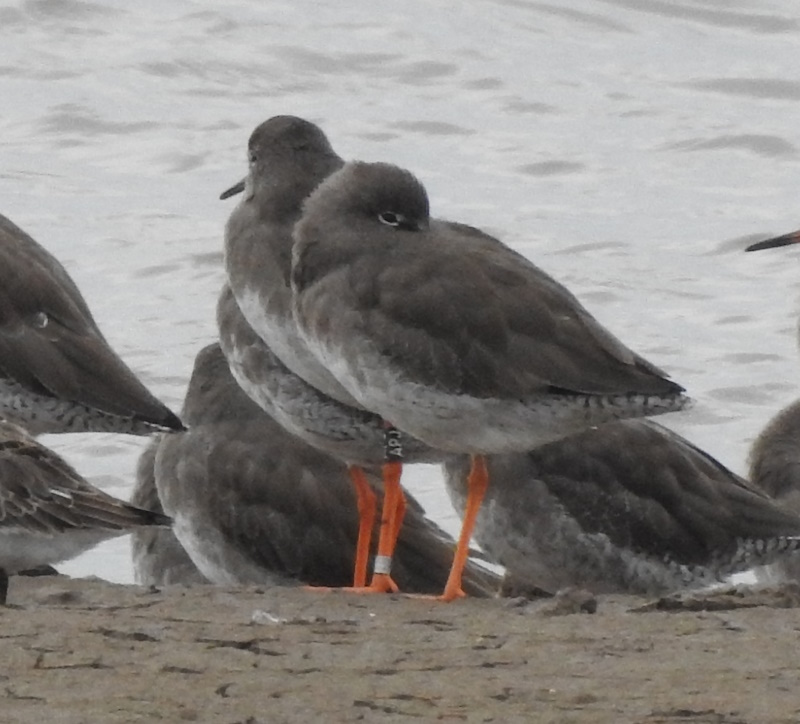
Orange - Black (APJ)
Ringed at Llanrhystud (near Aberystwyth) in November 2020.
Recorded at Llanon (also near Aberystwyth) in November 2021.
Seen at Heswall in September 2023 and 29/09/2024.
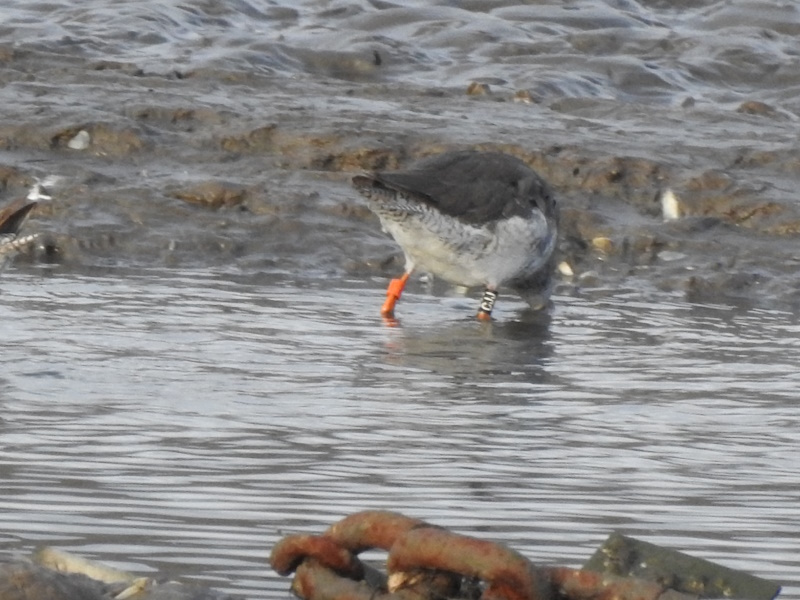
Orange - Black (CJJ)
Ringed at Ynyslas (south of Aberdyfi) in August 2023.
Recorded at Heswall on 21/08/2024.
Colour Rings were recorded by Richard
Smith, Stephen
Hinde, Colin Schofield,
Tony Ormond, Sean O'Hara, Steve Williams, Alex Jones, Richard
Speechley, Alan Hitchmough, Paul Ralston, Les Hall, Tony Ramsden, Tim
Vaughan, Nigel
Favager and Chris Wilding.
Richard Smith
September Bird News
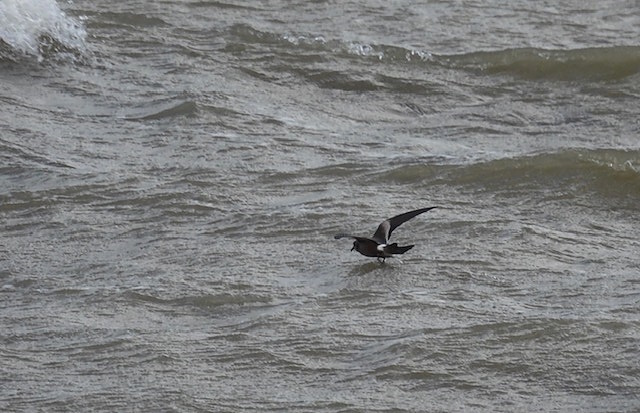
Strong north-west winds, which started blowing late on the 9th, blew in a good number of Leach's Petrels over the following two days. The highest counts were on the 11th with totals of 17 off Hoylake, 31 past Hilbre and at least 28 off Wallasey Shore. Other highlights were an adult (Hoylake) and 2 juvenile (Hilbre) Sabine's Gulls and a couple of Grey Phalaropes. 67 Manx Shearwaters, seen from Hilbre on the 11th, was a decent count for September but other seabirds, such as Gannets and auks, were largely absent. However, we couldn't complain about lack of Common Scoters over the following few days with 5,000 on a flat calm sea off Hoylake on the 17th and 3,500 seen in the air from Hilbre on the 29th.

There was a big influx of Pink-footed Geese through
the month. A handful arrived at the end of August but the first
significant flock was one of over 100 at Parkgate on the 11th after
which they started arriving in their thousands. Probably at least 5,000
flew over North Wirral on the 18th heading towards the marshes, and
over 4,000 were on Heswall Marsh and shore early on the 25th - I don't
know what the total numbers were for the estuary but I would guess it
would have been a record number for September. It is likely that many
of these were on their way to North Norfolk where they will stay until
January before returning here, numbers peak on the Dee Estuary in March
- see Pink-footed Geese article.
On Hilbre the first two Brent Geese arrived on the
6th and had built up to an impressive 158 by the 27th.
The Hudsonian Godwit remained on the marsh to the south of Flint Castle up to the 11th, and a couple of weeks later it was reported from the Mersey Estuary. A Yellow-browed Warbler was on Hilbre on the 20th, the earliest ever record there. An Osprey was seen with a large fish on East Hoyle Bank on the 18th, before flying south.
The Curlew Sandpiper passage was virtually
non-existent, we had more in the spring! Two were at Holyake on the
6th, followed by just one more on the 16th. One, at the Point of Ayr on
the 8th, was the only other record. Little Stints likewise with just
two at Hoylake on the 3rd and 6th. Usually by mid-September most of the
Sandwich Terns are gone with just a few single-figure flocks left, so I
had a nice surprise when I came across 132 on New Brighton shore on the
25th.
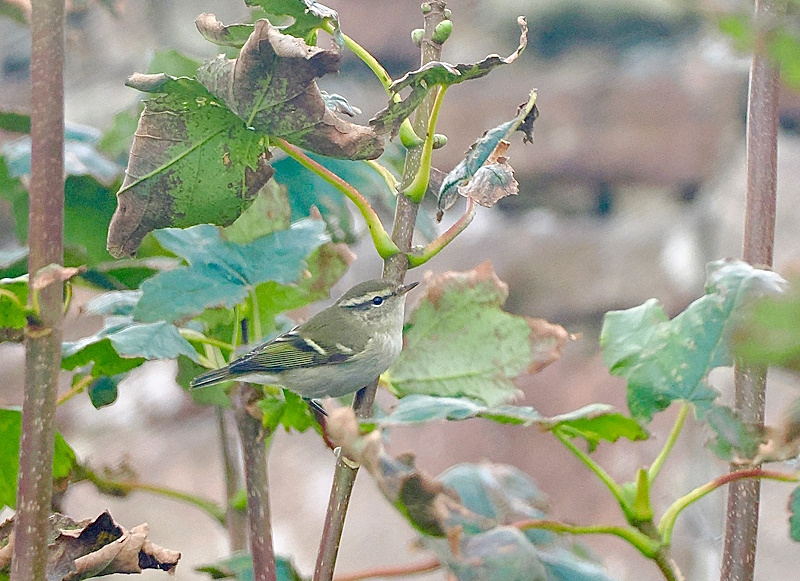
What to expect in October
A nice south-east breeze with an overcast sky should be good for 'vis
mig', shorthand for visible migration. Prime spots for thisare along
north wirral, Hilbre, Thurstaston and Point of Ayr - early morning is
usually best and we can see flocks of finches (usually mostly
Chaffinches), Starlings, Redwings and Fieldfares. Given the right
conditions these can run into thousands of birds, and it was only two
years ago when we had record numbers of Redwings flying over - see "A
massive Redwing Migration".
We've already had good numbers of Pink-footed Geese
arriving here but expect to see several thousand more this month, an
amazing sight and sound.
October is often a month for rarities and these should include Yellow-browed Warblers. 2016 remains the best year for this species this century - read about them here - "Yellow-browed Warbler Influx 2016".
If we get some north-west gales these should bring
in Leach's Petrels and other sea-birds. On the marshes there will be
both Hen and Marsh Harriers, as well as Short-eared Owls, and plenty of
Cattle Egrets, Great White Egrets and, hopefully, Spoonbills.
October Highest
Tides:
Oct 17th 11.35hrs (BST) 9.8m
Oct 18th 12.15hrs (BST) 9.9m
Oct 19th 12.56hrs (BST) 9.9m
Oct 20th 13.37hrs (BST) 9.7m